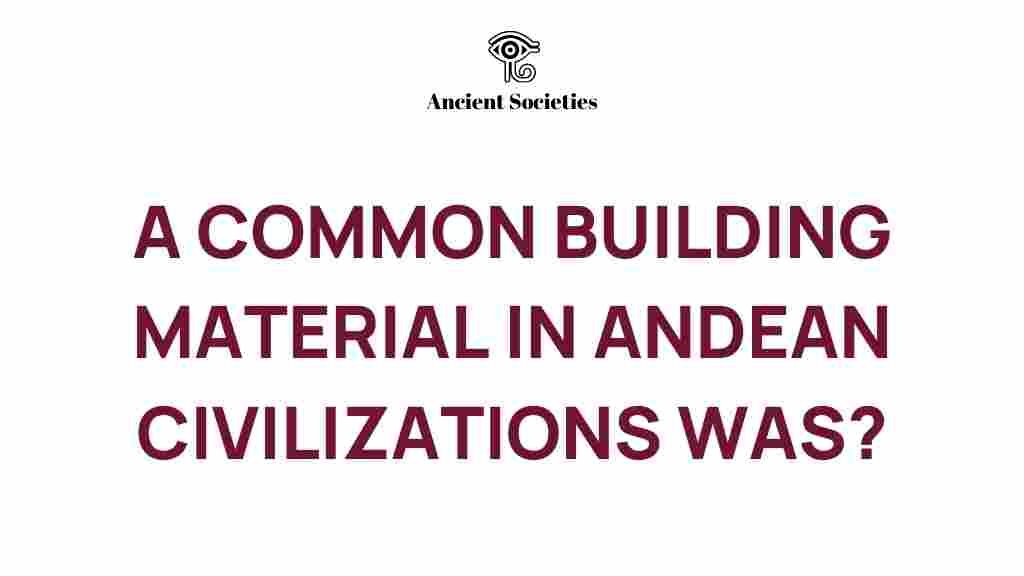The Surprising Role of Adobe in Andean Civilizations’ Legacy
The Andean civilizations, known for their rich culture and remarkable architectural feats, have left an indelible mark on history. One of the most intriguing aspects of their construction techniques is the use of adobe. This ancient building material, made from clay and other natural elements, played a crucial role in the architecture of the Andes. In this article, we will explore the significance of adobe in the context of Andean civilizations, its historical roots, architectural applications, cultural implications, and its relevance in today’s sustainable construction practices.
The Historical Context of Adobe in Andean Civilizations
Adobe has been used for thousands of years in various cultures around the globe, but its role in Andean civilizations is particularly noteworthy. These ancient societies, including the Incas, Moche, and Nazca, thrived in a diverse environment ranging from high mountains to coastal deserts. The availability of clay and other natural materials made adobe a practical choice for construction.
- Incan Architecture: The Incas are perhaps the most famous Andean civilization. They utilized adobe in building their impressive structures, including temples, agricultural terraces, and cities. Their use of adobe was essential for creating durable buildings that could withstand the region’s seismic activities.
- Moche Temples: The Moche civilization is known for its large adobe brick temples, such as Huaca del Sol and Huaca de la Luna. These structures demonstrate the advanced construction techniques and artistic capabilities of the Moche people.
- Nazca Geoglyphs: While not constructed from adobe, the Nazca culture’s use of the surrounding landscape, including adobe structures, reflects their architectural ingenuity and cultural importance of construction.
Understanding Adobe as a Building Material
Adobe is primarily composed of a mixture of clay, sand, straw, and water. This combination creates a sturdy and sustainable building material that has stood the test of time. The process of making adobe involves several steps:
- Gathering Materials: The primary components needed are clay, sand, and organic materials like straw.
- Mixing: The materials are mixed in a specific ratio to form a malleable substance.
- Molding: The mixture is then shaped into bricks using wooden molds.
- Drying: The molded bricks are left to dry in the sun until they harden.
This method of construction not only made use of locally available materials but also ensured that buildings were well-suited to the local climate. Adobe structures are naturally insulated, keeping interiors cool in the heat and warm during cold nights.
The Architectural Significance of Adobe
Adobe played a pivotal role in the architectural landscape of Andean civilizations. The flexibility and adaptability of adobe allowed for the creation of various architectural forms, from simple homes to monumental structures.
- Residential Buildings: Typical homes in Andean communities were constructed using adobe bricks, providing a comfortable living space that blended harmoniously with the environment.
- Religious Structures: Temples and ceremonial sites often utilized adobe, reflecting the spiritual significance of these constructions.
- Fortifications: Many ancient sites featured adobe walls as defensive structures, showcasing the material’s strength and durability.
Cultural Implications of Adobe in Andean Civilizations
The use of adobe extended beyond mere construction; it was deeply interwoven with the culture and identity of Andean civilizations. Adobe structures often served as community gathering spaces and held significant cultural and historical value.
- Art and Decoration: Adobe allowed for intricate designs and decorations, showcasing the artistic skills of the builders.
- Community Identity: The style and construction of adobe buildings reflected the values and identity of the community, creating a sense of belonging among inhabitants.
- Preservation of Traditions: The techniques and knowledge surrounding adobe construction have been passed down through generations, preserving cultural heritage.
Sustainability and Modern Applications of Adobe
In today’s world, sustainability has become a crucial consideration in construction. Adobe is witnessing a resurgence as a sustainable building material due to its numerous ecological benefits:
- Low Environmental Impact: Adobe is made from natural materials, reducing the carbon footprint associated with many modern building materials.
- Energy Efficiency: Adobe’s thermal properties help in maintaining comfortable indoor temperatures, reducing the need for heating and cooling systems.
- Local Availability: Utilizing locally sourced materials supports the local economy and minimizes transportation emissions.
Modern architects and builders are increasingly interested in incorporating adobe into contemporary designs, blending ancient techniques with modern aesthetics. For more information on sustainable building practices, you can check out this resource on sustainable construction.
Common Challenges in Adobe Construction
While adobe offers numerous benefits, there are certain challenges that builders may face:
- Moisture Sensitivity: Adobe can be vulnerable to water damage if not properly protected. Adequate drainage and protective coatings can mitigate this issue.
- Labor-Intensive Process: The traditional methods of adobe construction require significant labor and time investment.
- Seismic Considerations: In earthquake-prone areas, additional engineering may be required to ensure the stability of adobe structures.
Conclusion: The Enduring Legacy of Adobe in Andean Civilizations
Adobe is more than just a building material; it is a testament to the ingenuity and resilience of Andean civilizations. The ancient techniques used in adobe construction not only provided practical benefits but also played a significant role in shaping the culture and identity of these communities. As we move towards a more sustainable future, the lessons learned from the use of adobe in history can inform modern architectural practices, ensuring that the legacy of Andean civilizations continues to inspire future generations.
By understanding and appreciating the role of adobe in the past, we can better recognize its potential in addressing contemporary building challenges while embracing sustainability, culture, and history.
This article is in the category Archaeology and created by AncientSocieties Team
